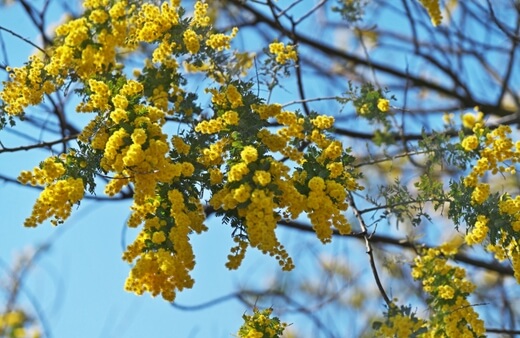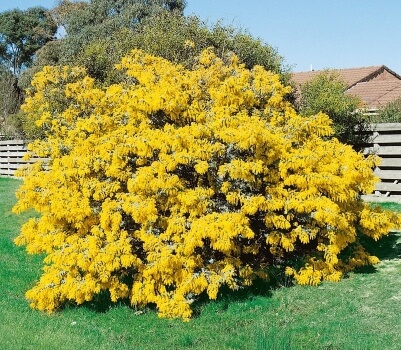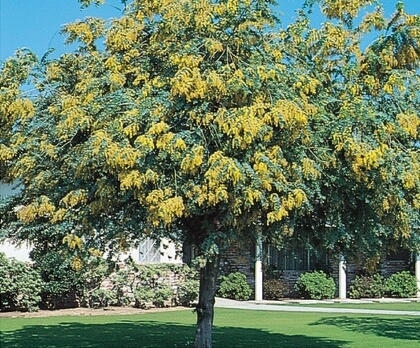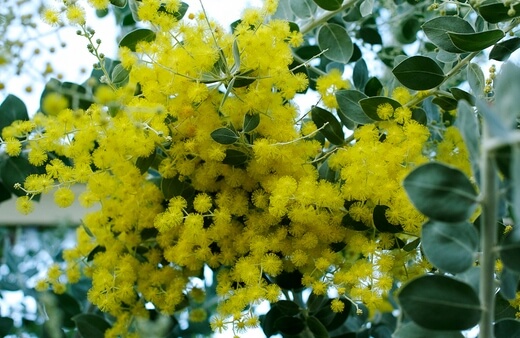Acacias might be short-lived, but they know how to pack a lot into their limited lives. Cootamundra Wattle has to be one of the most underrated acacias you can grow in South Eastern Australia, with a gorgeous cone form, neatly and symmetrically towering over whatever landscape it happens to be sat in.
As well as being part of the edible, bush tucker wattle group, Cootamundra wattle is a truly spectacular ornamental tree, which will help to improve your garden soil by capturing, storing and enriching its surroundings with nitrogen and various minerals too.
But, more importantly, it’s easy to grow. Let us share some of our own expertise with this fascinating genus of plants, as we run through how to grow Cootamundra wattle, how to care for it, and how you can propagate your own at home.
More...

Family: | Fabaceae |
|---|---|
Genus: | Acacia |
Species: | A. baileyana |
Common Names: | Cootamundra Wattle |
Location: | Outdoor |
Type: | Tree or shrub |
Growth: | (H) 6m x (W) 3m |
Sun requirements: | Full sun |
Foliage Colour: | Silvery green |
Flower Colour: | Yellow |
Flowering: | Winter and Spring |
Fruit: | Edible seeds |
Maintenance level: | Low |
Poisonous for pets: | Non-toxic to cats and dogs |
What is Cootamundra Wattle?

Cootamundra wattle is a tree, often pruned into a shrub form, native to New South Wales. Like all wattles, Cootamundra wattle is a ready self-seeder, and does tend to spread in the garden, but young trees have shallow roots and are simple to remove, so I’d personally put them in the low-medium maintenance category.
Cootamundra wattle can be invasive outside of NSW, and can harm populations of other native wattles, particularly in WA and the Northern Territories. There are sterile hybrids you can plant in these parts of the country, but it’s often better to plant other species of wattle.
The spherical flowers form into bright yellow pom poms in a mix of fully anthers, stamens and petals that covers the entire tree in winter in early spring, but for the majority of the year, this papery-leaved evergreen provides interest through its bristling silvery foliage.
Natural Habitat of Acacia baileyana
Native to New South Wales, and Cootamundra specifically, the Cootamundra wattle thrives in well-drained soil and is incredibly drought tolerant. In its native habitat, hot summers are a regular event, and rain falls heavily when it does, so balancing water and nutrients in the garden can be challenging.
Once established, tree form Acacias do not need irrigation or fertiliser, but they are both useful if you intend to harvest the wattle seed for culinary use.
How to Grow Cootamundra Wattle
Growing Cootamundra wattle is really pretty straightforward, but there are some particular considerations that don’t apply to most ornamental trees. Follow our guide below for step-by-step instructions on preparing the ground and choosing the right spot for Cootamundra wattle.

Source: D&H Seed Harvest Co
Planting Conditions for Acacia baileyana
Once you’ve prepared the soil, and found a good spot to plant your Cootamundra wattle tree, dig a hole that’s twice as deep, and twice as wide as the tree itself. Aim to dig a square hole, as the angled corners stop the roots from spiralling, and encourage lateral root growth (particularly important for these soil-enriching trees, which benefit from a wide root run).
Plant your tree so the surface of its root ball is level with the surrounding compost, and then soak it before backfilling with garden soil or compost. Keep Cootamundra wattle well-watered for the first few months, but do not over-water. Boggy conditions will rot the root ball.
Light & Temperature
Acacias are hardy, but only down to about -5, so protect young trees from frost with a few layers of horticultural fleece if you’re expecting freezing temperatures through mid-winter. Other than that, just find a bright, sunny spot, with 6-8 hours of direct sun per day (or more).
Acacia can cope in part-shade, but the majority, including Cootamundra wattle, prefer to be in full sun as much as possible to prevent fungal problems, and limit the presence of pests, particularly in gardens.
Soil & Drainage
Once you’ve found a good spot in the garden, with plenty of bright sunlight, it’s important to get the drainage just right. For maximum yields, Cootamundra wattle performs best on slightly moist, nutrient rich soil, with good drainage.
Finding the balance is tricky, but most Australian gardens, particularly in cities, will be well worked, and should have slightly better moisture retention than the native environment of these trees, meaning they’ll set seed more evenly and you’ll have a bigger harvest.
If, however, you’re simply growing Cootamundra wattle as an ornamental shrub or tree, make sure the drainage is free flowing. Water well for the first year, and mulch in late summer to enrich the soil and ensure the roots establish faster, but then leave them to their own devices.
How to Propagate Acacia Cootamundra Wattle
Cootamundra wattle grows from seed or cuttings without the need for any special treatment, and you can even propagate dried seeds if you soak them for long enough (though the success rate will be lower).

Source: Australian Outback Plants
Propagating Cootamundra Wattle from Seeds
To propagate Cootamundra wattle from seed, you’ll need some reasonably well drained soil (compost, soil, coir compost… anything at all), and a seed tray. Because wattle is so easy to propagate, you really can use any planting medium here – any seeds that are still viable will germinate, so it’s more about choosing the strongest seedlings and helping them to thrive.
- Start by filling a seed tray with compost or soil (old fruit punnets will work too).
- Thinly sow fresh wattle seed over the compost (for old wattle seed, or dried seeds, soak them overnight first).
- Water the whole tray until the soil is evenly moist but not soaked.
- Leave it in a sunny spot, or on a windowsill for about 3 weeks.
- Germination times are erratic but most seeds should sprout.
- Thin seedlings to about 2” apart, and leave them to grow on the outside in their tray for a few more weeks.
- When seedlings reach 10-15cm tall, gently prick them out into individual pots.
Note: This is best done in spring.
Propagating Acacia baileyana from Cuttings
Cootamundra wattle takes well from cuttings, but due to its brittle branches and stems, it's essential to take greenwood or softwood cuttings, rather than hardwood cuttings. Simply choose a branch from a mature Cootamundra wattle tree, and cut back about 20cm from the tip, either in autumn or spring.
(It’s important to choose a stem with no sign of emerging flowers or flower buds, as these stems have focussed hormones that distract from rooting.)
Make a sloped cut just below a node, and insert it into free draining compost. Position the pot somewhere in light shade, away from afternoon sun, and keep the soil reasonably moist. The cutting should root after about two months, and should be ready to plant out by the following summer.
Caring for Cootamundra Wattle
After planting, there are some simple ways to support Cootamundra wattle trees, and the most important is physical support, or staking. Acacias are not great at coping with high winds for their first few years, so adding a loose stake that allows the tree to rock, but not bend is important.
After that, Cootamundra wattle care depends entirely on how you want to use the tree.

Mulching
Ornamental Cootamundra wattle trees don’t require any mulch or fertiliser, but applying a light layer of compost in summer can help to boost their seed production (though un-mulched trees will still produce hundreds, if not thousands, of seed pods).
Fertilising Acacia baileyana
Acacia are efficient at drawing their own nutrients in from far and wide. It’s what makes them such useful trees in the garden, and why we love them so much here.
Adding fertiliser to healthy Acacia trees can actually be detrimental, so avoid amending your soil unless there are clear signs of nutrient deficiencies (yellow leaves in combination with well-drained soil, or dropping unripe seed pods can both be signs of magnesium or calcium deficiency).
Watering Cootamundra Wattle
Young Cootamundra wattles should be watered in well when they are first planted, and then left alone. For the first few months it may be necessary to water the ground immediately around the trunk if there’s a particularly hot summer.
Pruning and Repotting
Acacia can be grown as a shrub, and will respond well to heavy pruning, but always cut back above a bud to encourage new growth, rather than stunting it. Cootamundra wattle is, like all acacias, able to withstand pruning, and works well as a shrub when kept to about 2m tall.
However, I would strongly suggest leaving this tree to grow into its full form as it is one of our most stunning native trees, and makes an incredible floral statement in winter when it reaches maturity.
Cootamundra Wattle Pests and Diseases
Cootamundra wattle has no commonly reported pest problems in Australia and is pretty disease free. If you notice yellowing leaves it may be due to incredibly poor soil conditions, so add calcium or magnesium:
- For mature plants, add granular fertilisers to the surface of the soil about 2m away from the trunk (this encourages the roots to draw nutrients in more naturally).
- For young plants, apply a liquid fertiliser near the trunk to provide quick support for nutrient and mineral deficiencies.
Cootamundra Wattle Frequently Asked Questions

How long does Cootamundra wattle live?
Cootamundra wattle is very short lived, with a lifespan of just 10-15 years. In nature, this can be even shorter, so growing Cootamundra wattle in your garden can add a few years to its life, if you provide your wattle tree with protection for extreme frost and high winds.
Where does Cootamundra wattle grow best?
Cootamundra wattle grows best in full sun, on slightly acidic soil with reasonable fertility. Avoid heavy clay, or improve your soil with grit and sand to make a manageable environment for these drought tolerant trees.
Does Cootamundra wattle have invasive roots?
Cootamundra wattles have strong roots that spread rapidly, but they do not typically damage property. In pots and containers, they will nearly always break through the walls or crack ceramic pots if left for too long in small containers.
Is Cootamundra wattle invasive?
Cootamundra wattle is a native species, but its heavy seed production and easy germination pose a risk to other native species when it is planted outside of its native zone in NSW.
How tall does Cootamundra wattle grow?
Cootamundra wattle grows to about 30ft (9m) tall, with a spread of up to 40ft (12m), though in ideal, open conditions, it will be taller than it is wide, producing a neat conical form.
Does Cootamundra wattle have deep roots?
Cootamundra wattle has wide roots, rather than deep roots, which spread out to draw in nutrients. However, in really well drained soils, Cootamundra wattle can send down roots as far as 20ft into the ground in search of water.
How long does Cootamundra wattle take to grow?
Cootamundra wattle is fast growing and can reach its mature heights in as little as five years. Allowing one or two seedlings to remain in place is a good idea after ten years, when the tree may begin to fade, before dying at around 15 years old.
Do ticks like Cootamundra wattle?
The Wattle tick scale, despite its name, is not a tick. It is a scale insect with a swollen ovoid body, mimicking the appearance of ticks. They do not cause significant harm to their host trees, and will only cause very mild rashes if they bite humans (rare).
What month does Cootamundra wattle bloom?
Cootamundra wattle starts blooming in early to mid-June, and will go on flowering until mid-spring. In most parts of Australia, that winter-spring flowering window is reliable, but can vary slightly on the East coast.
Do birds like Cootamundra wattle trees?
Wattle seeds make great food for parrots, pigeons, and pretty much any foraging bird. Their bark is also easy to peel back, so insectivores like Cockatoos are able to forage for insects too, particularly on older trees.
Will Cootamundra wattle grow in shade?
Cootamundra wattle will grow in part shade, but won’t tolerate full shade. These trees need at least 6 hours of direct light for healthy growth. So while they may cope with 4-6 hours of direct light per day, they certainly won’t thank you for it.
Why is my Cootamundra wattle tree dying?
If your Cootamundra wattle tree is dying, it may be caused by overwatering or poor drainage, which can cause root rot and fungal problems. If you’ve planted your wattle properly, on well-drained soil though, it may be more complicated (such as nutrient deficiencies in the soil).
However, if all is well in the soil, your Cootamundra wattle may just be getting old, and need replacing.
Wrapping Up Our Cootamundra Wattle Growing and Care Guide
At the risk of repeating myself, Cootamundra wattle is a stunning tree, both ornamentally, and in terms of its culinary use. Of all our native Acacias, this tree is one of the best adapted to cold spells and summer droughts, and its mature canopy is truly special.
To grow your own Cootamundra wattle at home, start from seeds or cuttings, and make sure you’ve got a bright spot with good drainage. If you can get that right, you’ll have great success growing your own Cootamundra wattle in the garden.
Published on January 30, 2023 by Gary Clarke
Last Updated on February 22, 2024





Whilst an Australian native, Acacia baileyana is an environmental weed throughout many areas of South-Eastern Australia outside of it's natural range.
Due to it's high seed load and potential to hybridise with local species, it is causing havoc in some areas, impacting on protected bush land areas.
Please consider carefully before planting this species, there are potentially local species to your area that are just as vibrant and beautiful, but won't risk the future biodiversity in your local bush.
Hi Pete,
Most Acacias are ready self-seeders, so definitely need care taken when planted in gardens – Golden Wattle is no less invasive than Cootamundra. But it’s a fair point. It is a big country, and plants from one coast can do harm on another.
There are sterile Cootamundra wattle hybrids, but I’m aware it can be difficult to prove that they are being sold honestly.
Best regards,
Gary Clarke